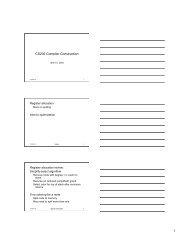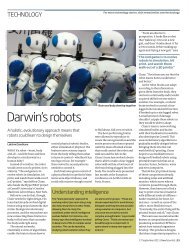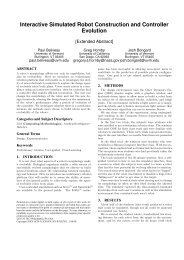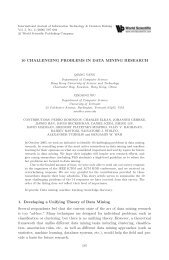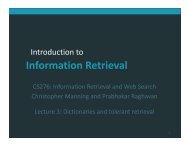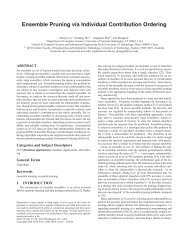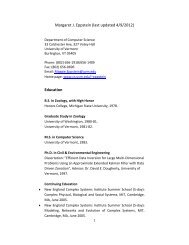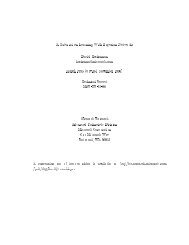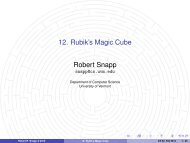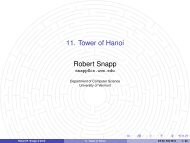Resilient robot adapts to environment | COSMOS magazine
Resilient robot adapts to environment | COSMOS magazine
Resilient robot adapts to environment | COSMOS magazine
Create successful ePaper yourself
Turn your PDF publications into a flip-book with our unique Google optimized e-Paper software.
<strong>Resilient</strong> <strong>robot</strong> <strong>adapts</strong> <strong>to</strong> <strong>environment</strong> | <strong>COSMOS</strong> <strong>magazine</strong> http://www.cosmos<strong>magazine</strong>.com/node/857<br />
<strong>COSMOS</strong> <strong>magazine</strong><br />
news<br />
features<br />
opinion<br />
fiction<br />
reviews<br />
gadgets<br />
media room<br />
samples<br />
News<br />
<strong>Resilient</strong> <strong>robot</strong> <strong>adapts</strong> <strong>to</strong> <strong>environment</strong><br />
Marie Theresa Bray<br />
Cosmos Online<br />
SYDNEY: A star-shaped <strong>robot</strong> that can adapt <strong>to</strong><br />
changes <strong>to</strong> its body and the <strong>environment</strong> has been<br />
built by U.S. scientists.<br />
Humans and other animals adapt <strong>to</strong> such changes<br />
by altering their behaviour. Robots, on the other<br />
hand, are usually less versatile, and fail <strong>to</strong> recover<br />
from unanticipated situations.<br />
But in a paper published <strong>to</strong>day in the U.S. journal<br />
Science, researchers describe a new <strong>robot</strong> that can<br />
sense changes - <strong>to</strong> its body or surroundings - and<br />
adapt its movements accordingly, an ability that<br />
would be invaluable in unknown or dangerous<br />
terrain.<br />
A team led by Josh Bongard of the University of<br />
Vermont in Burling<strong>to</strong>n built the four-legged <strong>robot</strong><br />
that uses tilt and angle sensors in its joints <strong>to</strong><br />
observe its own movements. It then creates a<br />
concept of itself on an internal computer.<br />
"In the first phase of the <strong>robot</strong>'s life, it is somewhat<br />
like a human infant: it knows very little about its<br />
own body, but quickly discovers that it's made up of<br />
four legs, and that it can move those four legs in a<br />
certain pattern <strong>to</strong> walk," said Bongard.<br />
The four-legged <strong>robot</strong> that <strong>adapts</strong> <strong>to</strong> changes <strong>to</strong> its<br />
body or <strong>environment</strong>.<br />
Image: Science<br />
After damage <strong>to</strong> the <strong>robot</strong>'s body, it creates a new self-concept: <strong>to</strong> simulate injury the researchers<br />
shortened one of the <strong>robot</strong>'s legs.<br />
"In the second phase, the <strong>robot</strong> senses that those self-models are no longer appropriate, and searches for<br />
a new description of itself. By doing this it discovers what and where the damage is on its body," said<br />
Bongard.<br />
Using this new, updated view of itself, the <strong>robot</strong> can internally rehearse new manoeuvres <strong>to</strong> accommodate<br />
its injury, and continue with its mission when it finds a way <strong>to</strong> solve the problem.<br />
The <strong>robot</strong> builds an understanding of itself using "actuation-sensation relationships", said the researchers.<br />
In this process, it momentarily switches on some of its mo<strong>to</strong>rs, then senses the resulting orientation of its<br />
body.<br />
The <strong>robot</strong> then calculates how much the action has caused its body <strong>to</strong> tilt left or right, forward or<br />
backward, and uses this relationship <strong>to</strong> deduce how it is put <strong>to</strong>gether.<br />
According <strong>to</strong> the researchers, their <strong>robot</strong> evokes human-like qualities such as curiosity: the <strong>robot</strong> is<br />
constantly trying <strong>to</strong> act in new ways, and <strong>to</strong> learn more about its body and its <strong>environment</strong>.<br />
"It also suggests something about self-awareness, because this <strong>robot</strong> literally builds ... a sense of self,"<br />
said Bongard.<br />
In a related perspective published in the same issue of Science, Chris<strong>to</strong>ph Adami from the Keck Graduate<br />
Institute of Applied Life Sciences in Claremont, California, also suggests that problem-solving <strong>robot</strong>s might<br />
not be so different <strong>to</strong> humans.<br />
Adami explains how a <strong>robot</strong> might operate in unknown terri<strong>to</strong>ry by first exploring the landscape, then<br />
dreaming up new ways <strong>to</strong> overcome any obstacles encountered.<br />
"A <strong>robot</strong> would spend the day exploring part of the landscape, and perhaps be stymied by an obstacle. At<br />
night, the <strong>robot</strong> would replay its actions and infer a model of the <strong>environment</strong>," said Adami. "Informally,<br />
then, the <strong>robot</strong> would dream up strategies for success … and approach the morning with fresh ideas."<br />
Bongard and colleagues believe that if a <strong>robot</strong> continues <strong>to</strong> produce new, adaptive behaviours in<br />
unexpected situations, it might provide information about how humans and animals adapt <strong>to</strong> their<br />
constantly changing <strong>environment</strong>s.<br />
Friday, 17 November 2006<br />
"Our <strong>robot</strong> maintains not just a single representation of its body, but constantly maintains and updates<br />
multiple competing possibilities. Perhaps animals and humans do the same thing," said Bongard.<br />
"We are always asking ourselves: 'What would happen if I did this, or did that? What would be the<br />
Latest News<br />
Chocolate good for<br />
your heart<br />
<strong>Resilient</strong> <strong>robot</strong> <strong>adapts</strong><br />
<strong>to</strong> <strong>environment</strong><br />
Supernovae shed light<br />
on dark energy<br />
Nanotech dangers<br />
demand attention<br />
Soy and fish lower<br />
cancer risk<br />
1 of 2 11/17/2006 9:41 AM<br />
more
<strong>Resilient</strong> <strong>robot</strong> <strong>adapts</strong> <strong>to</strong> <strong>environment</strong> | <strong>COSMOS</strong> <strong>magazine</strong> http://www.cosmos<strong>magazine</strong>.com/node/857<br />
repercussions?' Robots could be used <strong>to</strong> help us investigate how and why we do this."<br />
Aside from shedding light on human behaviours and contributing <strong>to</strong> philosophical debate, the research<br />
might also have practical applications - <strong>robot</strong>s that can adapt <strong>to</strong> unforeseen circumstances when exploring<br />
unchartered worlds.<br />
Privacy policy | Support | Terms and Conditions | RSS feeds<br />
©2006 Luna Media Pty Ltd, all rights reserved<br />
2 of 2 11/17/2006 9:41 AM



